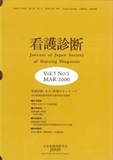Japanese
English
- 有料閲覧
- Abstract 文献概要
- 参考文献 Reference
12のNANDA看護診断カテゴリーの内容妥当性を検討すべく,看護経験5年以上,看護診断使用2年以上,看護診断知識を中程度以上と自己評価している214人のエキスパートを対象に調査した.12看護診断カテゴリーには,4つの〈セルフケアの不足〉(入浴/清潔,更衣/整容,排泄,摂食),〈不安〉,〈知識不足〉,〈非効果的コーピング(個人の)〉,〈絶望〉,〈睡眠パターンの混乱〉,〈疼痛〉,〈皮膚統合性の障害〉,〈感染のリスク状態〉が含まれる.10診断カテゴリーに合計34診断基準が見つかり,診断ごとには平均3ないし4であった.今回得られた診断基準は北米とほぼ共通していたが,日本独自と思われる診断基準もいくつか見つかった.〈非効果的コーピング(個人の)〉と〈絶望〉には診断基準が見つからなかった.正しい看護診断を導くためには,日本における診断カテゴリー明確化が重要なことや,文化的に妥当な診断指標の開発が必要なことが示唆された.
To examine content validity of the 12 NANDA diagnoses, 214 nurse experts with more than 5 years of clinical experience, with more than 2 years of nursing diagnosis use, and with at least moderate amount of self-rated knowledge of nursing diagnosis were selected. Twelve diagnoses included were four Self Care Deficit diagnoses (Bathing/Hygiene, Dressing/Grooming, Toileting, and Feeding), Anxiety, Knowledge Deficit, Ineffective Individual Coping, Hopelessness, Sleep Pattern Disturbance, Pain, Impaired Skin Integrity, and High Risk for Infection. Thirty-four critical characteristics and average of three to four per diagnosis, which were similar to the findings in American studies for the 10 diagnoses were identified. There are a few characteristics which were identified critical only in Japanese culture. For Ineffective Individual Coping and Hopelessness, no characteristics were identified as critical. These findings suggest the need for further clarification of concepts in Japanese culture and exploration of culturally valid defining characteristics.
Copyright © 2000, Japan Society of Nursing Diagnosis. All rights reserved.


